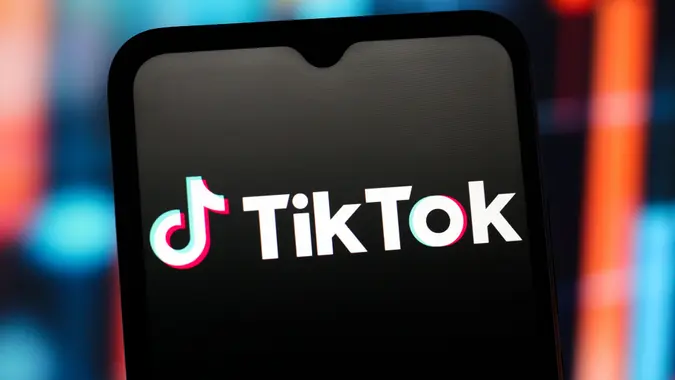How Do Loan Improvement Loans Work?

Commitment to Our Readers
GOBankingRates' editorial team is committed to bringing you unbiased reviews and information. We use data-driven methodologies to evaluate financial products and services - our reviews and ratings are not influenced by advertisers. You can read more about our editorial guidelines and our products and services review methodology.

20 Years
Helping You Live Richer

Reviewed
by Experts

Trusted by
Millions of Readers
A home improvement loan refers to a way to use a loan rather than a type of loan, as you can use any number of loan types to finance the improvements.
You might take out a home equity loan or line of credit that uses your home as collateral, for example, or an unsecured personal loan that requires no collateral. Whichever type you use, you’ll make monthly payments on the amount you borrowed, plus interest.
What Is a Home Improvement Loan?
Home improvement loans provide a way to pay for upgrades, renovations or repairs to your home. You borrow the amount you need to complete the work, then repay it via monthly payments.
Pros and Cons of Home Improvement Loans
Home improvement loans have several potential benefits, but it’s important to consider the drawbacks as well.
Pros:
- Might improve home value
- Fixed monthly payments, in most cases
- Multiple loan types to choose from
Cons:
- Adds to your debt
- Might require home equity
- Loan interest adds to project costs
Types of Home Improvement Loans
You can use any of the following loan types to finance your home improvements. Consider how suitable each one is for factors like:
- The size and scope of your project
- Your credit and other loan eligibility criteria
- How much equity you have
- Whether you’re willing to use your home as collateral
- Your long-term financial goals
Personal Loans for Home Improvement
A personal loan is usually unsecured, meaning you don’t need collateral. Most have fixed rates, so your interest rate and monthly payment stay the same for the entire loan term.
Personal loan rates are often higher than rates for secured loans. However, you don’t need home equity, so the amount you can borrow is limited only by the lender’s limits and your own credit, income and existing debt.
Personal loans make sense for smaller projects because you can borrow as little as $1,000. Many personal loans offer same-day approval, and funding within a business day or two.
Home Equity Loans
Home equity loans let you borrow against the equity in your home. Your home serves as collateral for the loan, and most lenders allow you to borrow no more than 80% or 85% of your equity in total, including any existing mortgage or home equity loans.
Home equity loans pay out your loan in one lump sum, just like personal loans do. Like personal loans, home equity loans usually have fixed rates. However, loan terms are potentially much longer — as long as 30 years.
Home Equity Lines of Credit (HELOC)
A home equity line of credit, or HELOC, gives you a revolving line of credit, similar to a credit card, instead of a lump-sum payment. Your home secures the loan.
HELOCs often have 15-to-30-year terms. Your credit line remains open during the first five to 10 years, which is the draw period. During the draw period, you usually make interest-only payments on the amount you’ve borrowed. However, you can repay that amount to restore your credit line and then reuse it, just like you might with a credit card.
The repayment period, usually lasting 10 to 20 years, begins after the draw period ends. Rates are usually adjustable, so your rate and payment can change over time, although some loans allow you to lock some or all of your balance into a fixed rate.
Keep in mind that lenders often quote promotional introductory rates for HELOCs. The standard rate could be higher.
Cash-Out Refinance
A cash-out refinance is a new first mortgage you take out for more than you owe on your existing mortgage loan. After repaying your existing loan, you can use the remaining funds for home improvements.
It’s important to note that your new rate could be higher or lower than the rate for your existing loan. Because you pay most of your interest in the early years of a loan, when the principal balance is highest, you’ll lose any headway you’ve made in tipping that balance with your existing loan.
The refi loan is subject to the same rules as your existing mortgage. For example, you’ll have to pay mortgage insurance if you borrow more than 80% of the home’s value, and you’ll have the same kinds of closing costs you had with your existing loan.
FHA Title I Property Improvement Loans
An FHA Title I property improvement loan lets homeowners with limited equity finance the cost of improving their properties. Although the loans are insured by the Federal Housing Administration, they’re issued through approved private lenders.
You can do the work yourself and finance the materials only, or hire a contractor and use the loan for materials and labor both. The maximum loan amount for a single-family home is $25,000, and you can take up to 20 years and 32 days to repay it with a fixed rate of interest. Loans for $7,500 or less have no collateral requirements.
How To Qualify and Apply for a Home Improvement Loan
Qualifications and application processes vary by lender and loan type, with secured loans — cash-out refinance loans in particular — requiring the most documentation.
Here are the basic requirements for home improvement loans:
- Good credit score (usually 620 or better for the best rates)
- Proof of income and employment
- Low debt-to-income ratio
- Home equity, for secured loans
After comparing loans and rates and choosing the loan want, you’ll fill out an application online, by phone or, if it’s a local lender, in person. Online applications have instructions and often, a number to call for support. If you apply by phone or in person, the loan representative will walk you through the process.
Comparison Table: Loan Types for Home Improvements
Here’s a side-by-side look at the different types of home improvement loans.
| Loan Type | Secured? | Best For | Typical Rates | Repayment Terms |
|---|---|---|---|---|
| Personal loan | No | Quick upgrades | 6.5% to 36% | 1 to 10 years |
| Home equity loan | Yes | Large projects | 6.50% to 8.13% for a 20-year term | 5 to 30 years |
| Home equity line of credit | Yes | Ongoing projects | 6.50% to 8.25% for a10-year draw, 20-year repay | 5 to 20 years, for total loan term of 15 to 30 years |
| Cash-out refinance | Yes | Combining home improvement with refinance | 5.75 to 7% for 30-year loan | 15 to 30 years |
| FHA Title I property improvement loan | If amount borrowed exceeds $7,500 | Borrowers with limited equity | Varies by lender | Up to 20 years, 32 days |
FAQ: Home Improvement Loan Basics
Take a look at some answers answers to most frequently asked questions about getting a home improvement loan.- What credit score do I need for a home improvement loan?
- You'll have the best chance of being approved with a score of at least 620.
- Can I use a personal loan to remodel my home?
- Yes, you can use a personal loan to remodel your home. A personal loan can be used for many different cases, but you might also consider whether or not a specific loan geared toward home improvement, renovations or remodeling might offer better terms.
- What happens if I can't repay my home improvement loan?
- The loan will go into collections. If it's an unsecured loan, the collection company might eventually sue you. If the loan is secured, the lender could foreclose and take possession of your home or certain portions of it, such as kitchen and bath fixtures or appliances.
- Is a HELOC or home equity loan better for home projects?
- A home equity loan might be better for one-time projects. A HELOC is often better for financing work you'll do over time.
- Can I get a home improvement loan with bad credit?
- You might qualify for a personal loan, but you'll likely pay a high interest rate.
Our in-house research team and on-site financial experts work together to create content that’s accurate, impartial, and up to date. We fact-check every single statistic, quote and fact using trusted primary resources to make sure the information we provide is correct. You can learn more about GOBankingRates’ processes and standards in our editorial policy.
- CBS News. 2025. "$100,000 home equity loan vs. $100,000 personal loan: Which is cheaper in 2025?"
- Federal Trade Commission. "Home Equity Loans and Home Equity Lines of Credit."
- Wells Fargo. "Loan amortization and extra mortgage payments."
- Rate.com. 2024. "What Is a Cash-Out Refinance? How Does It Work?"
- U.S. Department of Housing and Urban Development (HUD). "HUD Lender List Search."
- HUD. "Title I Manufactured Home Loan Program Allowable Loan Parameters"
 Written by
Written by  Edited by
Edited by 





















